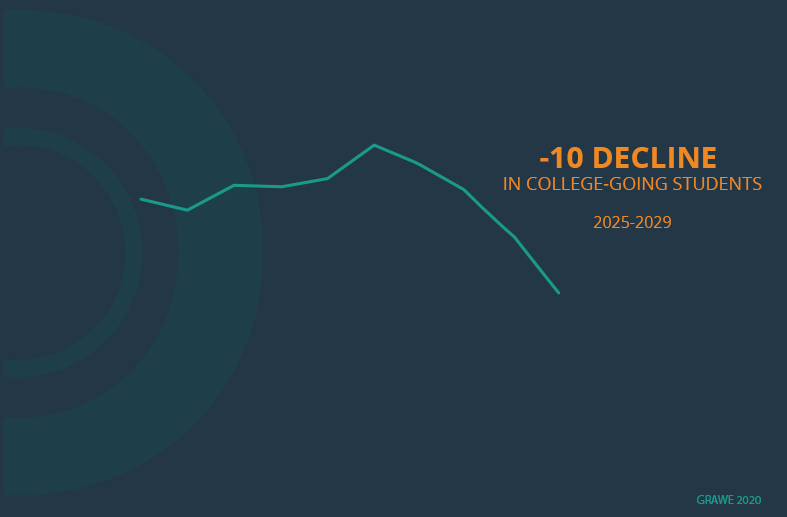How Will Higher Ed Institutions Weather the Demographic Cliff?

Andy Hannah
We're all familiar with the demographic cliff.
That’s when, in the mid-2020s, the number of traditional college-aged students is predicted to decline significantly. You can thank the low birth rates during and after the 2008 Great Recession for the cliff. But first, institutions will be lulled into a false sense of security because the college-aged population is predicted to increase until the mid-2020s.
The Common Perception about the Demographic Cliff
The demographic cliff has been the topic of many articles, Nathan Grawe’s 2021 and 2018 books, Demographics and the Demand for Higher Education and The Agile College: How Institutions Successfully Navigate Demographic Changes, the leading research on the topic, and Western Interstate Commission for Higher Education (WICHE) report.
Many think that the demographic cliff will be a common experience among all institutions—that every institution will see an increase and then a decline in enrollment of equal magnitudes.
But is that the case?
How will the regional differences, the regional variations in the population, cited in Nathan Grawe’s book and other studies, impact recruitment for individual institutions? We decided to examine this perception about the demographic cliff and what it means for U.S higher ed institutions in our research paper, Futureproofing Institutions Against the Demographic Cliff.
Methodology
To look at institutional differences, we developed forecasts for each institution of the number of high school graduates in that institution’s current geographic recruiting markets.
It is important to emphasize that the projections are based on where an institution recruits, not where the institution is located and assumes no change in recruiting strategy between now and the population decline.
Our Sample Data
The data we used for our research is a blend of Nathan Grawe’s 2018 data and the WICHE forecasts from their ninth publication. We also used publicly available geographic recruitment data for 454 institutions.
The institutions in the sample are in the United States and represent four-year colleges, both public and private, and large and small.
Findings
Here are a few findings from our research. Download the paper for a richer analysis of our findings.
The winter of enrollment is coming
The reduction in traditional college-age students will squeeze most schools. Eighty percent of the schools in the analysis will see negative growth rates over the next eight years.
It's where and how broadly you recruit that matters.
Where a school is located is not determinative of enrollment, but where they recruit is. How geographically concentrated your recruiting strategy is will determine how agile you can be in combatting declining growth rates.
Know your neighbors
It is important to understand the number of schools and types of schools that surround your institution.
Colleges located near national schools, the top schools listed in U.S. News and World Report, may suffer larger declines in the availability of potential recruits. National schools have strong brand identities and resources, positioning them to maintain enrollment and possibly absorb students who would have attended another institution.
Growth rates vary by region and by institution
The projected growth rates vary considerably across institution, even those located in the same state or city!
For example, the University of Chicago and University of Illinois-Chicago, both located in the city of Chicago, will be impacted by the cliff differently. University of Chicago is projected to see a relatively small, 4% decline in their market area, while the University of Illinois-Chicago is projected to see an 11% decline.
Best Opportunities for Future Growth
Institutions best positioned for the future either have a geographically diversified recruitment strategy and are already recruiting heavily in markets projected to grow.
A shift of focus to increasing retention will help many colleges and universities maintain enrollment.
Futureproof Your Higher Ed Institution with Advanced Analytics
Futureproof means anticipating the future and developing methods to minimize the effects of shocks and stresses of future events.
Institutions aware of the cliff and proactively thinking ahead can position themselves to weather the changes.
The first steps—knowing how the demographic cliff will impact your specific institution. You can read our report to gain an understanding of the broad impacts, and then request an individualized growth forecast for your institution. The deadline to request a growth forecast is April 16, 2021.
When you know where your college or university is positioned in terms of future growth rates, then you can develop strategies and tactics to take advantage of opportunities and counter the impact of the cliff.
That’s where advanced analytics can support your institution.
Advanced Analytics for Higher Education
Advanced analytics helps you better understand your individual students and how they will fit at your institution. It predicts student behavior and prescribes actions that will enable you to get the outcome you and the student are looking for.
Recruitment
When you’re recruiting students, you want students who are a fit, who will thrive at your institution and graduate to be successful alumni. Advanced analytics predicts which students in your enrollment funnel will be most likely to enroll at your institution. The student predictions can be aggregated into different student populations, offering recommendations on where and how you should be recruiting students.
That will be extremely helpful for growing your feeder markets (remember, it is where you recruit, not where you are located, that will impact your future enrollment) and stave off competition from national schools.
Retention
For student retention, advanced analytics identifies which students are at-risk of dropping out. When you know which students are at-risk, you can better allocate your resources to where they are needed most. You can also see what will positively or negatively impact a student or group of student’s retention scores.
That is extremely helpful when you’ve got limited resources to improve retention on your campus; advanced analytics tells you who needs you most, offers how they need you, and shows you where to put resources.
Recommended Reading:
Why Predictive Modeling in Higher Ed is a Must-Have
The 4 Steps to Using Data and Analytics to Help Students Succeed
How Advanced Analytics Can Help with Out-of-State Recruitment
Are You Prepared for the Demographic Cliff's Impact on College Admissions?
The cliff is coming; It’s inevitable. But knowing how it will impact your institution will prepare you to meet the challenges.
To get started, educate yourself. Read our report on the impact of the demographic cliff on future enrollments and request an individualized growth forecast for your higher ed institution.
The more you know, the more you can prepare to meet the challenges presented by the demographic cliff and futureproof your institution.
Patty Beeson is a co-author of the post.

Andy Hannah



